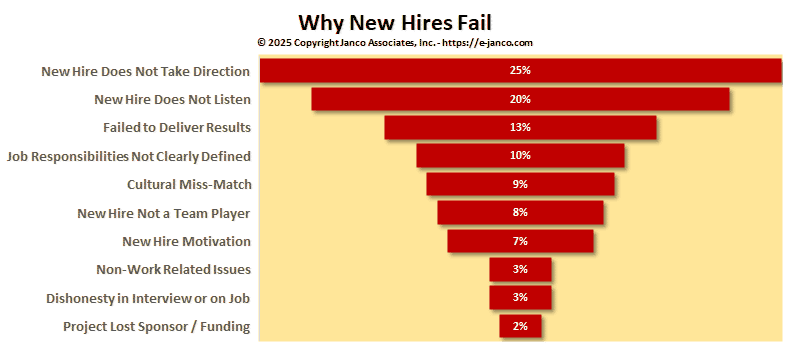Why New Hires Fail
With a limited number of qualified candidates, hiring is more difficult
A recent study found that over half of all hiring failures are due to two factors; interpersonal issues associated with the new hire (29 percent) and poor corporate culture fit (28 percent). Most of these can be filtered out during the recruiting and interviewing process.
To minimize these factors here are 10 tips of thing to consider or do in the recruiting process.
-
Do not hire based on an outdated job description. Times change and jobs change. Update the description. The most common mistake is not ensuring that the job posting aligns with the job. When filling a role where the former employee was in the role for a while, their duties shift, but often job postings don’t accurately represent all the other responsibilities that have been added over time, which can end up in misalignment. It’s important to capture all the responsibilities of the role before you start the recruiting process so the candidates who apply are aware of the role in its true and full form.
-
Look for team players. The single most important quality in an IT hire is compatibility with the existing team. A newly hired employee with a “hero mentality” should be avoided. The most successful employees bring up their entire teams enabling them to accomplish more than simple individual wins. Look out in job interviews for candidates who focus only on their own accomplishments.
-
Avoid inflated resumes. A bad IT hire is an individual who sells themselves well in the interview but exaggerated their skills. It is important for hiring managers to catch these types of candidates during the job search with a variety of skills testing.”
-
Avoid team killers. As a manager, you must consider whether it’s worth sacrificing one individual for the sake of the team, or the team for the sake of this one individual. In most cases, world-class managers choose the former option. The hardest part is when an individual is very good at their job but just did not fit in with the culture of the wider group.
-
Avoid poor skills fit. For example, an extremely bright candidate was hired into the wrong role. Everyone is impressed by how smart they are but frustrates the individual’s manager who was trying in vain to transform them into the role they need.
-
Validate motivation. Engagement during the interview process is a great sign of whether the candidate is truly excited about the role. If you’re transparent about the process and the culture and there’s a high degree of engagement, there’s a greater potential for a good fit.
-
Avoid red flags. You can spot any glaring red flags Do not give them access to confidential and sensitive information before there is any need to
-
Avoid inflexible hiring. When bringing on new team members, leaders that are willing to show some flexibility in their requirements are finding the most success
-
Avoid careless individuals. When and why did you start in IT? It’s been the best indicator of whether the candidate is going to be a good fit for the team.
-
Avoid the prima donna. Candidates who can’t get past their own opinions, causing rifts in his business technology department. When you push back and say it does not address all the questions or concerns, they are prone to shutting down.
Read on IT Hiring Kit Order IT Hiring Kit




